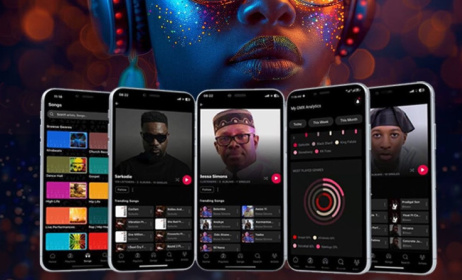How the internet is remaking music – and remaking us
Marshall McLuhan coined the phrase “the medium is the message” in his 1964 book Understanding Media: The Extensions of Man. In this work, he builds on the thoughts of Thorstein Veblen (and Karl Marx before him), outlining a kind of technological determinism, which asserts it is the forms of media we use that determine the cultural and intellectual values of our society – and not the other way around.
In its strictest form, technological determinism claims that industrialised society is relinquishing control over its political, social and ethical norms – and replacing these, instead, with technology’s internal logic of efficiency and productivity (and profit). This internal logic, it is argued, means that the medium itself comes to condition the content that it communicates, colouring the message to suit its own ‘needs’ of optimised functionality.
Neil Postman memorably picks up on this theme of contagion between technology and content, medium and message, in his cheerily titled 1985 book Amusing Ourselves to Death. Talking about the impact TV on cultural life, Postman writes: “The problem is not that television presents us with entertaining subject matter, but that all subject matter is presented as entertaining.”
The point of this article is to ask: what, if anything, can these media theorists teach us about modern music?
The ‘internetification’ of music
The ‘Napster Revolution’ is one term used to describe a confluence of different technological trends in the late 1990s that – basically – made it extremely easy to listen to music for free. These different trends included the digitisation of music (in formats such as MP3s), the increased availability of (faster) personal internet connections, and the rise of peer-to-peer file transferring platforms such as Napster.
Napster is still passionately discussed more than 20 years after its invention, and it is still credited for “nearly killing the music industry.” Between its emergence in 1999 and 2010 (the advent of streaming), though more music was being recorded than ever before, music sales dropped by a staggering 50% in a little more than a decade.
The result has been a dizzyingly fast transformation of the industry, as the music business has essentially moved online. Streaming music has jumped from a 7% market share in 2010 to over 80% today. This represents a growth in annual return from $1bn in 2012 to just under $19bn in 2022, with alternative forms of media contributing just 9% of market share last year.
Is online music any different?
If the medium is the message, then how has music changed since it moved onto the internet? An often-cited study spearheaded by Joan Serrà, a postdoctoral scholar at the Artificial Intelligence Research Institute of the Spanish National Research Council in Barcelona, examined more than half a million songs dating from 1955 to 2009. Serrà and his colleagues analysed their cache of songs on the basis of three criteria: timbre (sound colour, texture, or tone quality), pitch (the harmonic content of the piece, including its chords, melody, and tonal arrangements), and loudness.
The results are worth reading in detail, but (spoiler alert!) the report card doesn’t look good. Over the research period, the researchers found that songs have less variety in their instrumentation and recording techniques, and songs have become less harmonically complex. Thanks in large part to the audio compression of digital formats such as MP3, one area that songs have increased in is loudness – but this has come at the expense of dynamic range.
To sum up, songs have become less nuanced, more monotonous and more ‘samey’ – and all these trends are especially true since the mass digitisation of music at the turn of the 21st Century.
But what about streaming?
Has this evolution in the way people interact with digital music, at least, done anything to reverse the trend? Streaming has offered the recorded music industry a lifeline, but the reality is that record companies find their new position in the music industry somewhat compromised: a give and take between the demands of streaming platforms and their AI-driven recommendation algorithms. AI relies on data insights and these insights have increasingly been used – in both crude and very sophisticated ways – to engineer not only how music is playlisted and consumed, but songwriting itself.
This attempt to change music ‘on the backend’ is an effect of the stiflingly risk-averse environment of the post-Napster music industry, and it has led to a process neatly referred to as the ‘industrialisation of songwriting’ for the digital age.
Here, we see the ‘internal logic’ that our technological determinists warned about expressed in a perfect feedback loop: the algorithms promote what is popular, but they also define what is popular. Witness the growth of new genres of internet music – often called ‘streambait’ or ‘Spotify-core’ by music critics – as evidence of this trend, as more and more artists try to conform to these “data-driven systems of mood-enhancing background music.”
Swimming in the shallows
There is another aspect of media determinism. This is the idea that, far beyond changing the messages we intend to communicate, the forms of media we use also have the effect of changing us.
Just as content becomes conditioned by the medium of its expression, our minds are similarly conditioned by the technologies we use. As McLuhan puts it: “We shape our tools and they in turn shape us.”
In 2010, Nicholas Carr released a book called The Shallows: What the Internet Is Doing to Our Brains. An extension of a 2008 article he wrote for The Atlantic (Is Google Making Us Stupid?), in the book Carr develops the thoughts of Marshall McLuhan and Neil Postman by adding insights from neuroscientists such as Michael Merzenich and Eric Kandel. He argues that the technologies we use to find, store and share information “shape us” by rerouting our neural pathways and influencing the way our brains respond to new experiences. His concern throughout the book is that “the Net is remaking us in its own image”: a kind of technological determinism applied to the level of neuropsychology.
He explains how the internet “encourages the rapid, distracted sampling of small bits of information”, and how it is rewiring our brains to mimic an “ethic of speed and efficiency, of optimised production and consumption.” A consequence of this, according to Carr, is that “We are becoming ever more adept at scanning and skimming, but what we are losing is our capacity for concentration, contemplation and reflection.”
It is astonishing how these insights map onto the evolution of the music industry that this article has recapitulated. What’s more impressive is their predictive accuracy for what has developed since the year of the book’s publication (which coincides neatly with the advent of streaming). For example, Carr’s insistence on the “impatience of mind” that the internet inculcates is exactly mirrored by the fact that because most streaming platforms only tally up songs that are played for at least 30 seconds, artists are uniformly eliminating long intros and shortening the average length of their songs to maximise the streaming return.
To quote Neil Postman again, as he explains the difference between the dystopian visions of 1984 and Brave New World: “What Orwell feared were those who would ban books. What Huxley feared was that there would be no reason to ban a book, for there would be no one who wanted to read one.”
Losing control?
In this light, it is tempting to see the internet as not just another form of technology to freak out about, but a particularly unfortunate one – at least for popular music – and to ask serious questions about where we go from here. For example, without a genuinely new technology to drive a new form of mass consumption, are these trends actually reversible? And the hardest, most unavoidable question: if the internet is remaking us in its image, how long before we’re incapable of doing anything about it at all?
But let’s conclude with some optimism instead. For starters, it is worth remembering that the impact of new technologies on music can be non-linear, unpredictable and contingent on the emergence of other technologies and their ability to produce new social contexts for music. For instance, how cassette tapes and 8-tracks capitalised on the wider boom in car manufacturing in the 1960s – simultaneously bringing full-length albums back into vogue after the heyday of 45 RPMs, and birthing OG personalised playlisting in the form of mixtape culture.
In the future, there will be new contexts for the consumption of music that we have not yet imagined. We can take encouragement from the fact there are already signs of consumer pushback against the internetification of music. Sales of both vinyl records and cassette tapes have flourished in recent years, and, if we take the insights of the media theorists seriously, then this turn back towards analogue formats should be seen as more than just a fad.
If the medium is the message, then maybe just by choosing to listen to music offline, we have more power over its future – and our own – than we previously believed.


































Comments
Log in or register to post comments